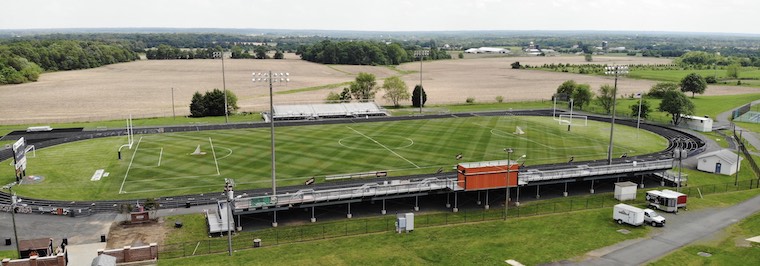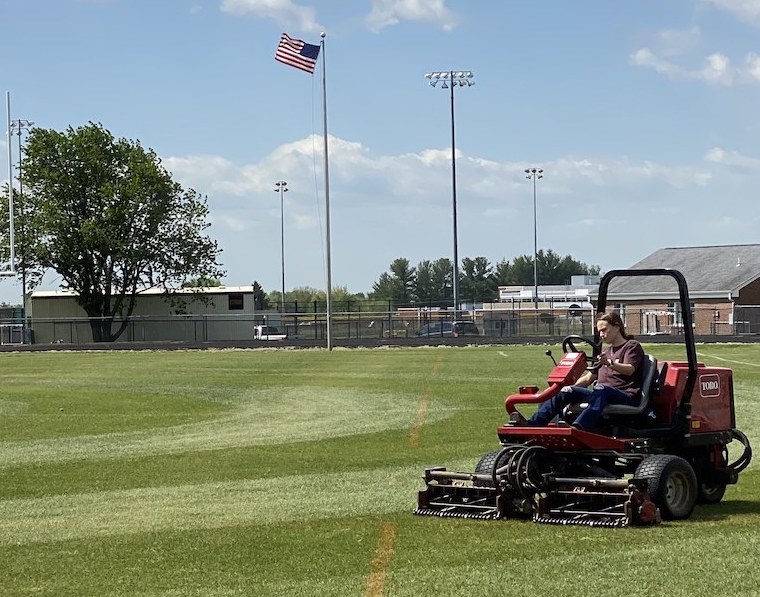By Drew Miller
In the sports field management industry, there are so many different components that go into the science and cultural practices for the overall management of natural grass playing surfaces. Still, one thing that stands out to the untrained eye is the crisp, bright stripes on the impeccable playing surface. Industry professionals have found that we are artists, and our fields are the canvas on which we paint with our brush – which happens to be a large piece of machinery.
Throughout my career, there have been many field managers who have pushed the limits of the complexity of a design to the point where the finished product truly is a masterpiece. I have always loved to try different field designs since the beginning of my career, but I gained skills working for Matt Brown. Matt pushes the envelope when it comes to mowing patterns at the Major League Baseball level, putting logos in the outfield, including his iconic Roberto Clemente Bridge silhouette. He taught me what it takes to create these designs while maintaining a consistent playing surface. Matt taught me that the artistry behind striping was something that we took pride in, because, with the extra time, energy and care that goes into these unique patterns, we took pride in the product.
As director of the Brentsville Turfgrass Management Program, I have had the opportunity to see my students gain a passion for what we all love to do – and that is care for our fields the best we can. Something that I pride myself on in this program is giving our students ownership of the creative aspect of field care – from our paint scheme for our end zones to the mowing pattern for the soccer state title game. Seeing how creative they are is truly incredible. It is great to see how they develop different designs by reviewing the everyday work of industry professionals. Our students truly love to study other techniques and patterns to develop their skills as sports field managers, while learning how to properly maintain the safest natural grass playing surface possible.
The most essential aspect of on-field artistry is to understand that no one wants to sacrifice proper ball roll or the safety of our players for field aesthetics. As sports field managers, we understand what level of artistry is considered to be within the bounds of maintaining the safest natural grass playing surfaces for our athletes.
Another reason that striping athletic fields truly is an integral part of what we do is that it is aesthetically pleasing, and it is a way for sports field managers to catch the eye of those who are unaware of what we do. A couple of years ago, our students developed a mowing pattern sampled from a couple different designs – including those of industry-leader John Ledwidge of Leicester City Football Club, and Billy Ellinger of the Pittsburgh Steelers. The students’ design was selected as the winner of the Sports Turf Managers Association’s annual Mowing Patterns contest that year. The design itself looks complex and is highly appealing to the eye. Still, it is crucial to understand that our students truly took into account the playability of our soccer players to ensure that there was nothing that impeded ball roll. There were no hazards for the players to trip on. It was just a design that brought the attention of many of our community members to the work of our students, and provided a better understanding of what a sports field manager is and the artists that they are.

There are sports field managers throughout the country who enjoy a classic look that is simple and eloquent, but I have always found my work to be more enjoyable when I am creative. There are so many individuals out there who have such incredible ideas, and that is what makes us unique as sports field managers. Every year, there is something new – from new mowing patterns to calcined conditioner designs in infield skins to new paint schemes.
Many people don’t see sports field managers as artists. But, when you take a step back and look at how grand our fields can be and how much time and effort goes into them, it is truly inspiring to my students and other sports field managers everywhere. Artistry on the field is such a critical part of our industry because it grabs the eye of the unknown viewer.
I bring this story up a lot, but I always go back to when I was a kid at Shea stadium, walking out to see the New York skyline etched into the outfield grass, not knowing how it got there. Over time, and by gaining understanding, it is unbelievable to see how my passion for field management has brought me to the point where I have been able to do similar things with my students at Brentsville.
I always tell my students that there are times where you need to take risks to truly be able to develop the design or the pattern that you hoped for, but to never risk any harm to the field because it is not about just the artistry. It’s about ensuring player safety and ensuring plant safety; but by having strong technical skills, we can produce these designs and enjoy the work that is being done.
I have been fortunate to meet and speak with so many sports field managers from around the world to discuss their passion and understanding, and how they view certain aspects of what we do as sports field managers. Something that I believe has been a common denominator – especially when discussing on-field artistry – is that no matter how complex the design is, every single individual takes great pride in his or her work. Their on-field artistry is truly a reflection of who they are as sports field managers. That is why, when I am working with my students at Brentsville, I have found it critical for them to understand the time, energy, care and the overall work that goes into their field is something in which they need to take pride. They are excited to have the ability to improve safety and playability, as well as the aesthetics, because that is where they gain the interest that then grows into a passion for sports field management.
As sports field managers, we find ourselves developing new and exciting artistic aspects of our fields, as well as new ways of expressing different key components of what is significant to the community. For example, we recently painted a design on our baseball field for one of our students who is fighting brain cancer to show our support and love. Everything we do has significance – whether that is aerating our fields to ensure healthy root growth and soil profile or taking care of crew members who need our help.
Neil Gaiman once said, “The world always seems brighter when you just made something that wasn’t there before.”
We come into work each and every day looking to create something new, brighter and more creative than the day before. That is why this is such an incredible life as a sports field manager, because we can be as creative as we want to be while always making a brighter day for those we serve.
Drew Miller is director of the Brentsville Turfgrass Management Program, located in Nokesville, Va. Miller is a graduate of Virginia Tech with a bachelor’s degree in Crops and Soil Sciences, focusing in Turfgrass Management, and a master’s degree in Career and Technical Education with a focus in Ag Education. Miller has spent the last four years developing a high school program and curriculum that prepares students for jobs in all areas of the turfgrass industry. Prior to that, he spent the majority of his career in professional baseball, football and collegiate athletics. Recognized nationally for his on-field artistry, Miller has won the STMA Stars and Stripes Contest, as well as the STMA Mowing Patterns Contest.


